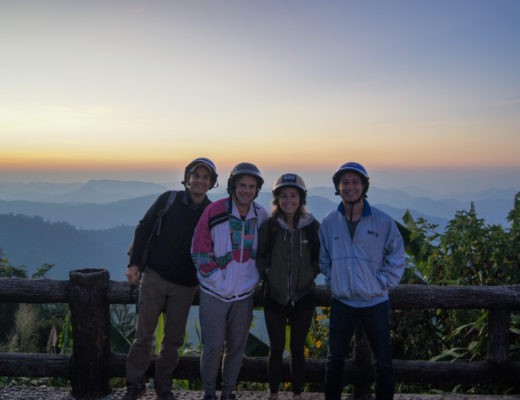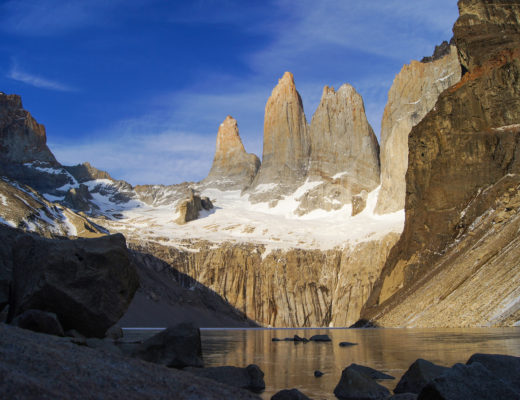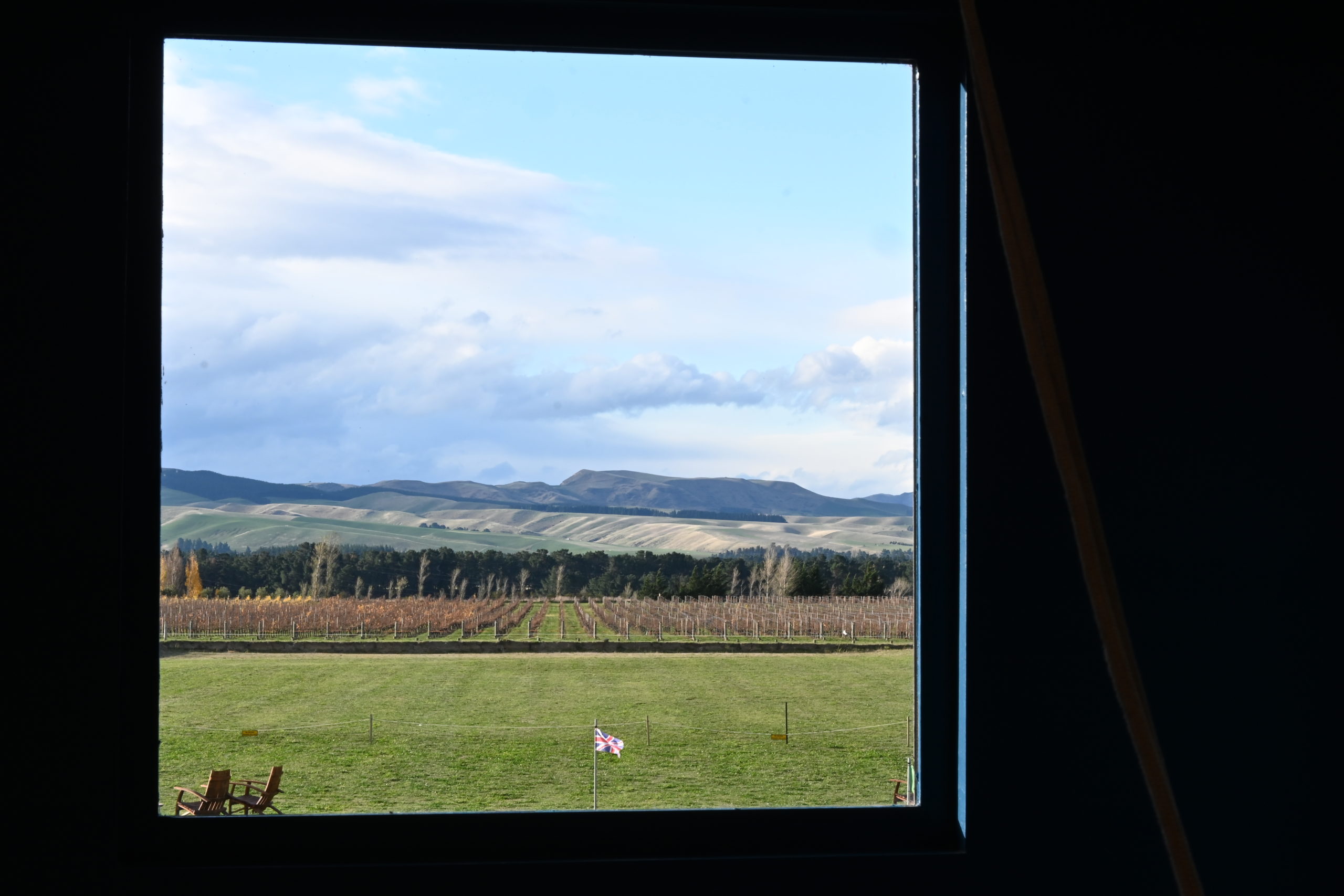Time for Me to Take a Break from Tennis and Go Travel
After struggling with tennis injuries during the second half of March and most of April, I decided that I was tired of sitting around or playing in pain and it was time for me to explore the world. Though I had the sudden urge to roam, I wasn’t quite ready to give up on my tennis dreams. I decided that I wanted to take a trip where I could recover from a nagging wrist and hamstring injury, while continue to stay active and fit.
After a few days of research, I decided it was time to visit the land of the Incas and see the famous city of Machu Picchu. I settled on this destination for a number of reasons, the top reasons being: Machu Picchu is on my bucket list; May is a good month to visit Machu Picchu, it marks the beginning of the dry season, and the hordes of tourists have not yet arrived; I was in the mood for some serious hiking which would keep me in relatively good shape; and lastly, South America was calling, having only visited Brazil once for a three-day work project, the continent demanded I pay it a visit.
Just one week after deciding to visit Peru, I found myself boarding a plane heading to Lima, Peru. I was stoked to begin my world travels!
Exploring Lima, Peru
Most everyone who visits Machu Picchu first flies to Lima, the capital of Peru, and then travels to Cusco, where they embark on either a trek, train, or bus bound for Machu Picchu. Instead of simply passing through Lima, I decided to spend a few days in the city in order to soak up some Peruvian culture and get in the travel mindset. Instead of my typical regimented day spent eating, exercising, and hitting the “outside edge” of tennis balls, I expected my day to transform into a chaotic amalgamation of new and unplanned experiences.
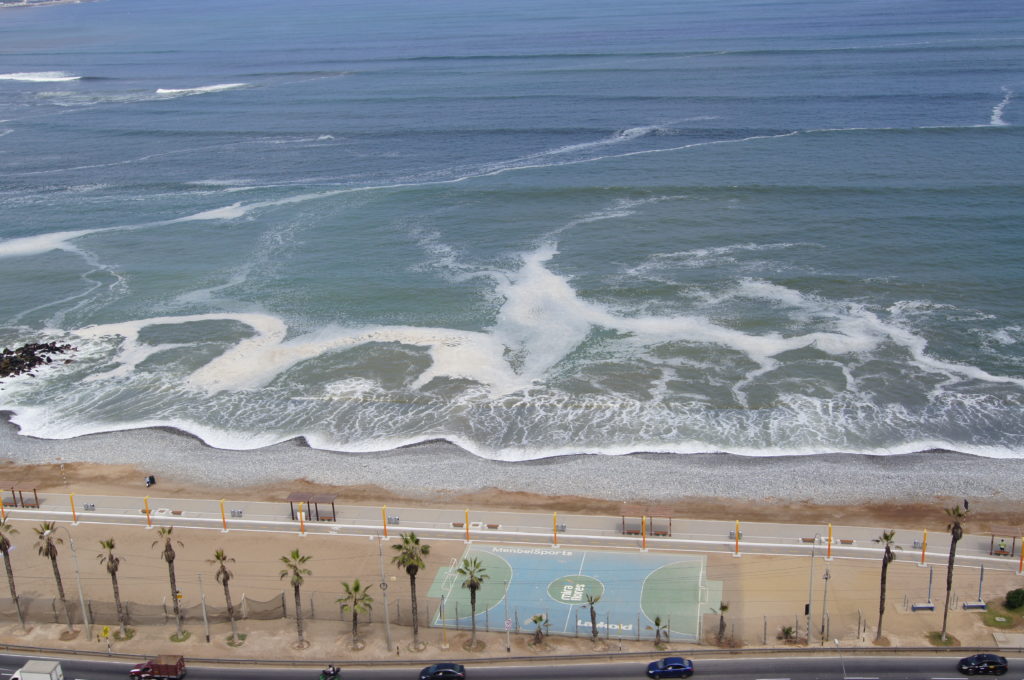
I explored Lima for a couple of days and, while it may not be a city with grand architecture or amazing history, it is a city with a vibrant culture, delicious food, and striking coastal views. Even if only for a day or two, I believe Lima is worth a visit.
My Lima Favorites
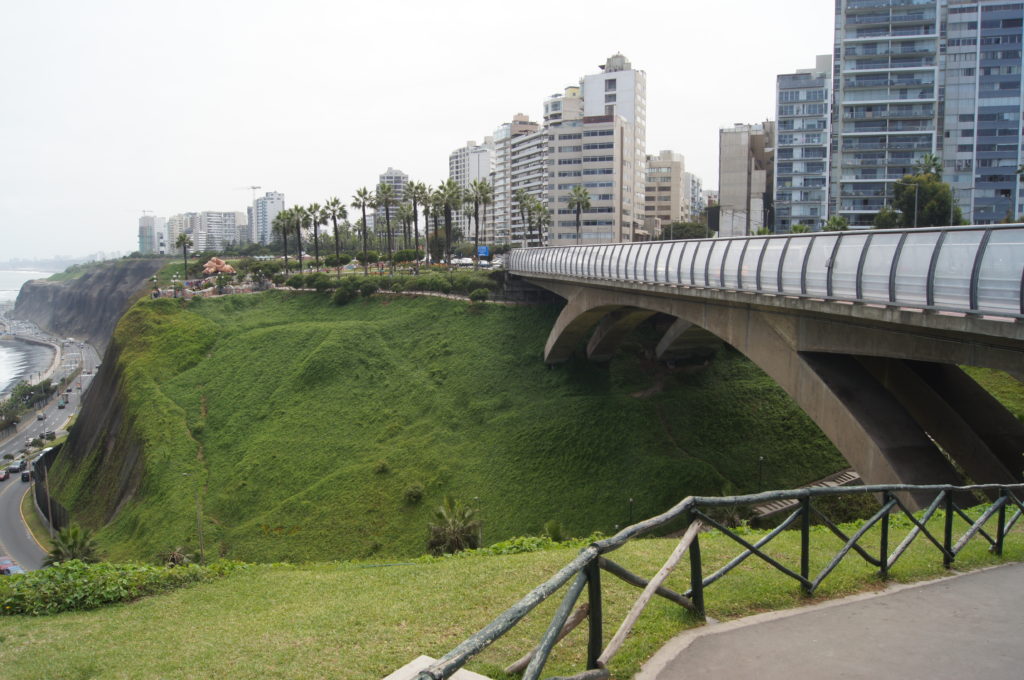
Walk along the coastal bluffs in the Miraflores district. This coastal walk awards you beautiful views of the Pacific Ocean, bluffs, and the city of Lima. I recommend either walking, renting a bicycle, or even paragliding, up/down the coast. While walking in the tranquil Parque Del Amor and all along the coastal path, I noticed how hundreds of locals were: enjoying their lunch, playing with their kids, walking their dogs, gossiping with their friends, all while staring out over the cliffs and enjoying the panoramic ocean views. I am always captivated and moved when I see locals in other countries taking time to enjoy good company and a gorgeous view – this act of relishing the moment is a bit rarer in the States and I am hoping to bring some of it home.
Eat some delicious Peruvian food. While on my Peruvian adventure, locals on a number of occasions exclaimed, “Peru is the food capital of South America”. I’m not sure if this is a self-ascribed title, but the Peruvian chefs certainly knew what they were doing in la cocina. Although not a fan of ceviche, which is one of Lima’s specialties, I was impressed with many of my meals. My favorite two dishes were: “La Causa”, a traditional Peruvian potato dish often served with chicken, and a “Chicharrón” (pork rind) sandwich, which I enjoyed not once, but three times at La Lucha Sanguchería Criolla, a famous sandwich shop in Miraflores.
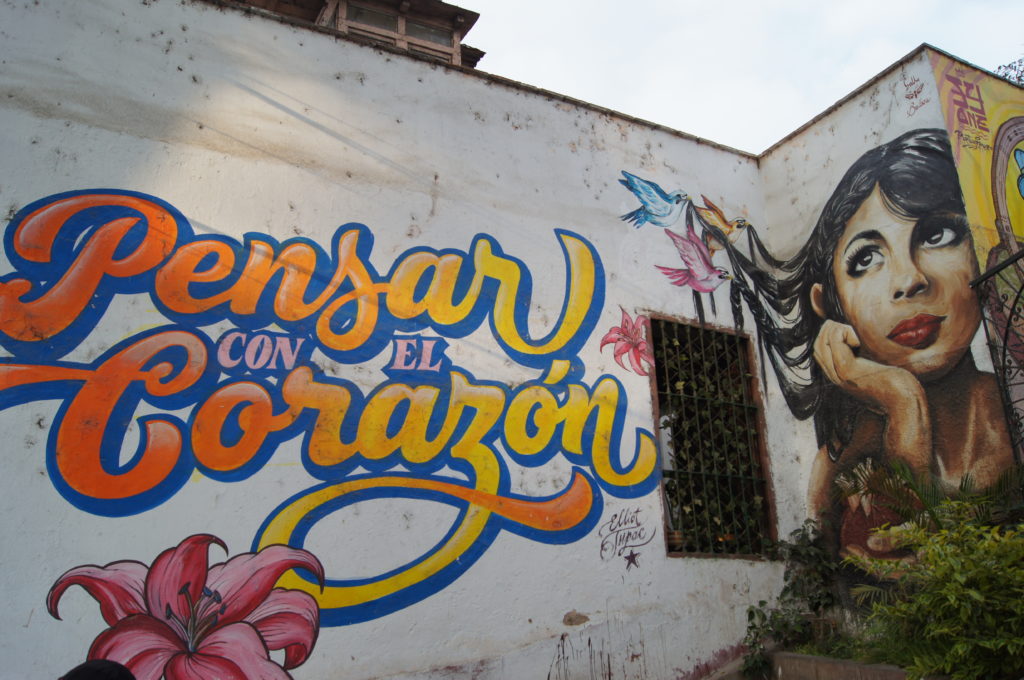
Visit El Barranco. Barranco is a safe and affluent district that is a 10 minute taxi ride south of Miraflores (district where most tourists stay). It is the colorful, hipster, street art enveloped, “Brooklyn-ish” district and is worth a visit both during the daytime and at night. During the evening, I recommend grabbing a seat at the bar at “La Noche” to enjoy some live music with the locals.
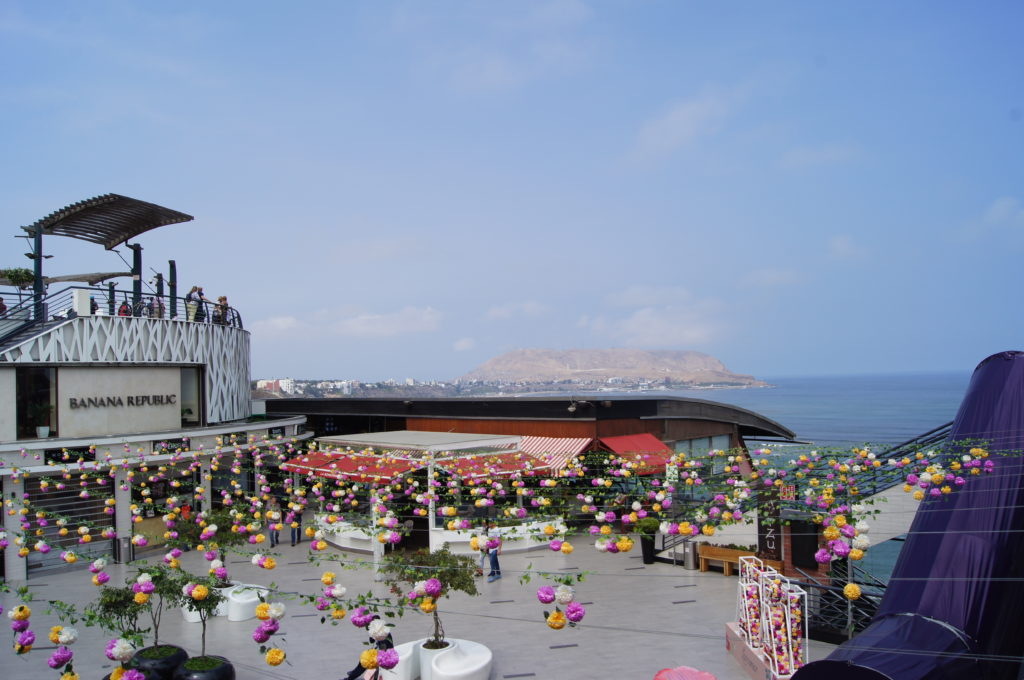
Visit Larcomar shopping center. Although a bit touristy and pricier than other areas in Lima, this outdoor shopping mall is built into the Miraflores cliffs and its restaurants boast incredible views of the ocean. It is a terrific place to grab a bench and people watch.
Try Pisco Sour, the national drink of Peru; it is both potent and delicious. A Pisco Sour is comprised of Pisco, lemon juice, simple sugar, egg whites (for foam), and bitters for garnish. It weighs in at ~ 45% alcohol content and reminds me of a Kamikaze or Lemon Drop in the States. After a night out in El Barranco, I’ll admit that I didn’t feel great the next day; after all, I had probably consumed a total of four glasses of wine over the previous 10 months while training. It did make me feel slightly better knowing that I had consumed 8+ egg whites, plenty of protein, with all that Pisco!
Other bonuses. Lima has safe districts, is inexpensive, and enjoys a pleasant climate all year long.
Acclimatizing in Cusco, Peru
Next, I flew to Cusco, the starting point for my hike to Machu Picchu. Cusco sits at an altitude of 11,300 feet (3,445 meters) and was once the capital of the Inca Empire. Upon arriving in Cusco, the altitude struck me immediately; suddenly, I found myself thinking about each breath. Breathing no longer felt like an automatic process performed subconsciously by my body, instead it was work. My first three thoughts upon arriving in Cusco were: 1) I can’t breathe; 2) sorry Denver, “the mile high city”, I’m no longer impressed by your altitude; and 3) can I hit the golf ball as far as Dustin Johnson at this elevation? Keep dreaming, Tanner.
During your time in Cusco you have a few options: you can take a day trip to visit nearby historic sites, such as The Sacred Valley and the Ollantaytambo fortress; you can take a 3 hour bus trip to visit the Rainbow Mountains of Peru; or you can just explore Cusco. I chose to explore, and before I knew it, I was: hiking up to the Saqsaywaman ruins; visiting the Statue of Christ overlooking Cusco; making friends with a Canadian couple (shout out to Braden and Amanda); visiting Korikancha “the sun temple”: and snacking on alpaca and guinea pig. To be completely honest, I wasn’t a huge fan of guinea pig. But, if Peruvians want to enjoy some guinea pigs during celebratory occasions, I’m not going to stop them. I’ll sit and watch while sipping on a cold and refreshing Pisco Sour. You do you, Peru.
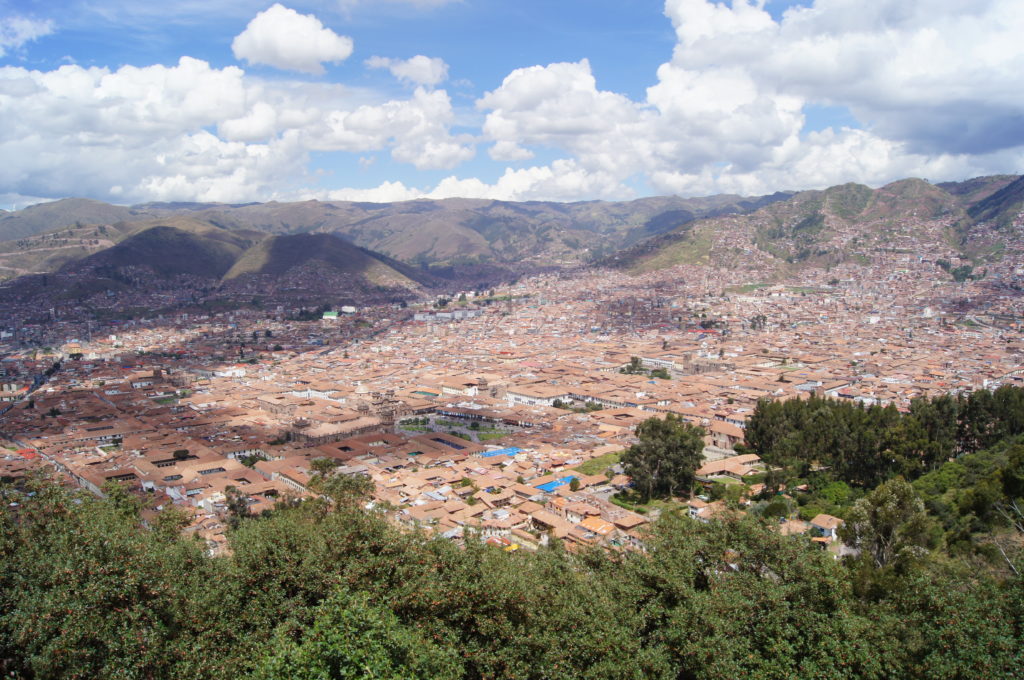
There are a number of different treks that begin in Cusco and end at Machu Picchu. The three most popular routes are the: Inca Trail, Salkantay Trail, and Lares Trail. The Inca Trail is the most famous and popular of the bunch, but this trail requires a permit and can be overcrowded with tourists. I selected the Salkantay Trail, which is slightly more rigorous than the Inca Trail, significantly less crowded, and many argue that the topography and biodiversity cannot be beat. When I saw a picture of Salkantay Mountain and learned that the trek crossed through the Salkantay Pass right below the face of the mountain, I was sold. I later learned that the Salkantay Trek is rated by National Geographic as one of the 25 Best Treks in the World. And, if I haven’t convinced you yet, I urge you to go on the Calm meditation app and listen to “The Trail to Machu Picchu” sleep story. After listening to this story, I would not be surprised to find you hiking the Salkantay route next week!
Salkantay Trek to Machu Picchu
Day 1: Cusco – Soraypampa – Humantay Lagoon – Soyrococha
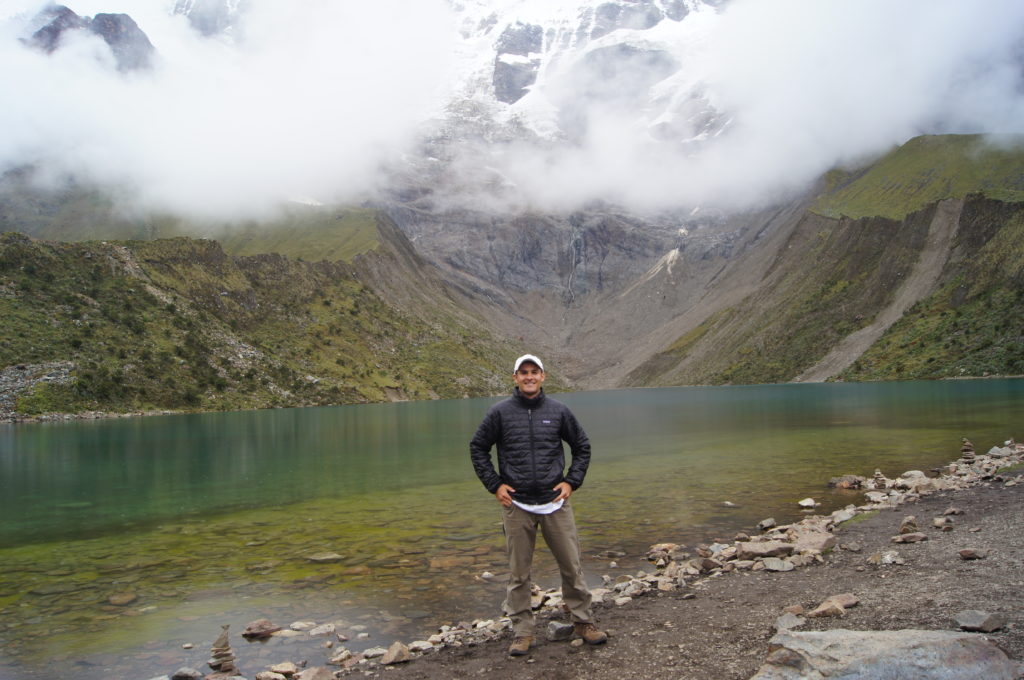
An epic start to an epic trek. The first day of the Salkantay Trek was everything I had hoped it would be and more. At the start of the journey, we could spot the peak of the Salkantay Mountain jutting out high above the surrounding terrain. Fast forward a 3.5 hour car ride and a full day of hiking and we were suddenly up close and personal with the “Savage Mountain”.
A highlight of Day 1 was visiting the Humantay Lagoon, a stunning glacial lake that sits at the foot of the Humantay Mountain. This lagoon is definitely worth a visit, and many hikers were doing a day hike to the lagoon and were not completing the entire Salkantay Trek. By dusk, we reached our first campsite, which was located at 14,400 feet (4,389 meters) and was situated right below the face of the Salkantay Mountain. I loved that our tour group was the only group camping at this location. To top off an incredible day, the southern hemisphere stars were the brightest stars I have ever seen, and I happily stood shivering and gazing at the stars long after the rest of my fellow explorers had retired to their tents.
Day 2: Soyrococha – Salkantay Pass – Huayrachmachay – Colpapampa
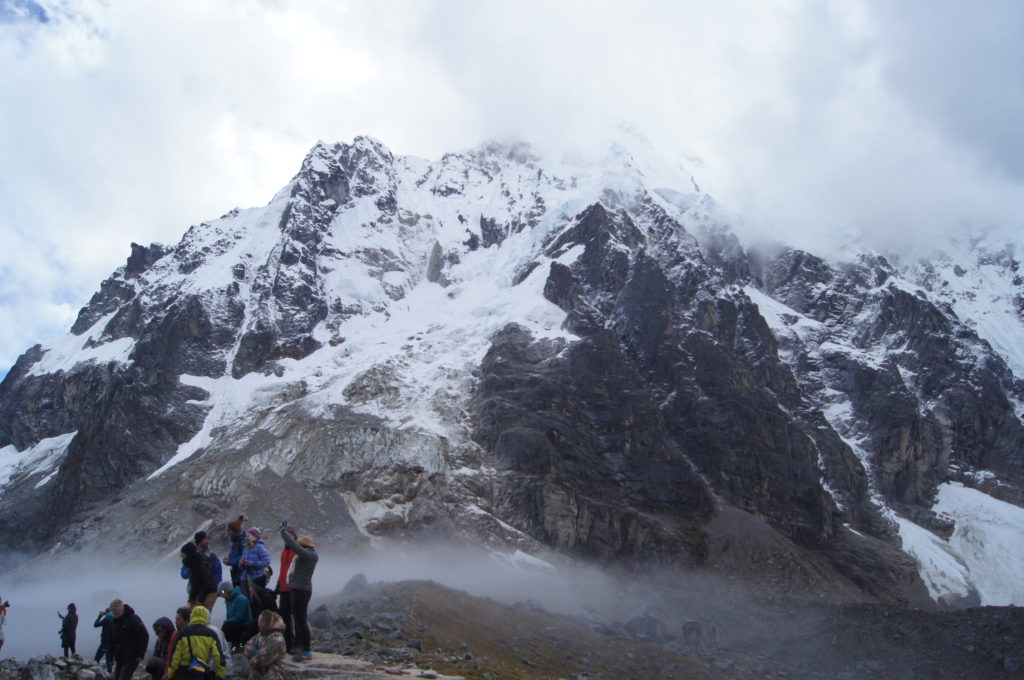
I will admit that I have very little experience camping out overnight. Additionally, I have never slept, or even breathed, at an altitude of 14,400 feet. The high altitude, combined with the fact that my metabolism works outrageously fast and as a result I was super hungry throughout the night, resulted in me getting no sleep. Not a wink. As a result, as my fellow travelers would surely agree, I wasn’t my normal self on Day 2. Sorry team. That being said, luckily, even with a hamstring injury, I was in good shape and I was able to complete the 20 mile journey on Day 2.
Upon ascending to the Salkantay Pass we were greeted with an avalanche, a safe distance away, and I was impressed with the raw power of nature. The views of the face of the mountain and views looking down from the pass were unequivocal to anything I had ever seen. You have to see it for yourself! The climb to the pass was quite difficult, because even though my legs are strong, at 15,100 feet it was nearly impossible for me to continue without stopping every five steps and catching my breath. Besides the views from the pass, another highlight of the day was seeing the Salkantay Lake, which I believe could have inspired the color of Gatorade’s “Glacier Freeze”. After descending down the mountain the rest of the morning and after a 4 hour afternoon hike, we arrived at our campsite in the cloud rain forest and it was time to refuel and re-energize with a tasty dinner and a deep slumber.
Day 3: Colpapampa – Lucmabamba – Santa Teresa Hot Springs
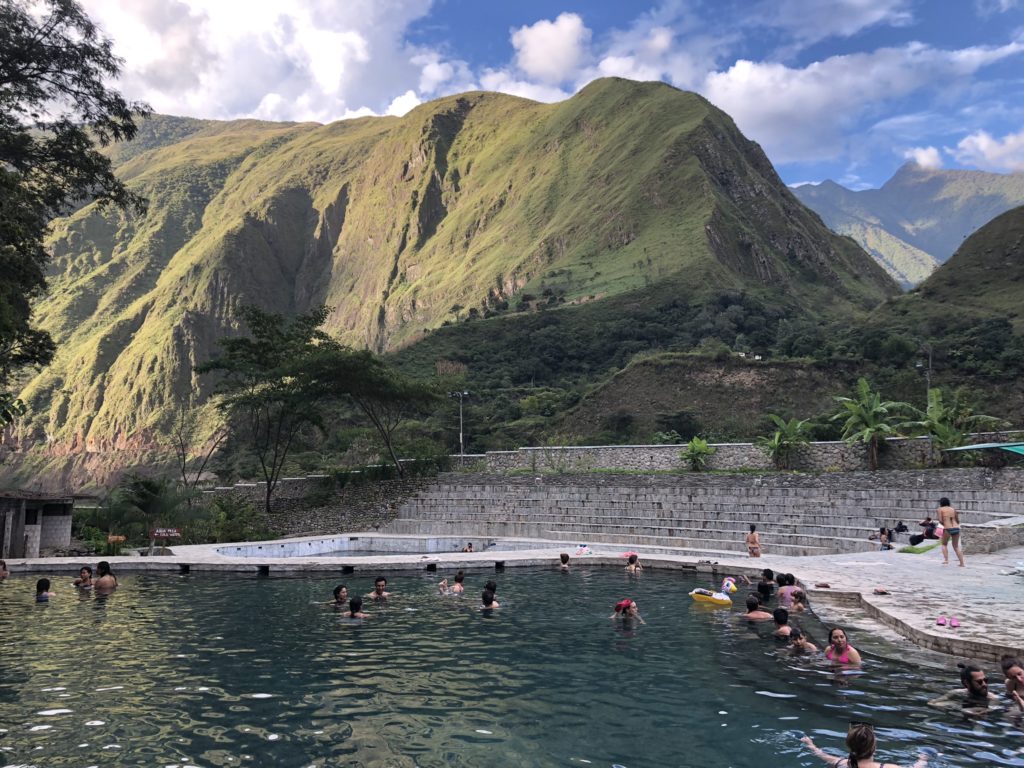
It was nice to have an easier hiking day on Day 3 of the trek. Also, it was nice to be back to my normal self after a good night’s rest. We spent the morning hiking in the cloud rain forest; it was crazy how the previous morning we were bundled up in every layer we had brought, now we were sweating in our t-shirts and shorts. In the afternoon, upon arriving at our Lucmabamba campsite, at an elevation of 8,500 feet, we picked, roasted, and ground our own coffee beans. Later on, we drove down into Santa Teresa and visited the hot springs. Although the water could have been a few degrees warmer, relaxing in the springs with friends, and enjoying the spectacular mountain views definitely made the springs a worthwhile stop.
Other highlights of the day, included: picking up a 70 year old Peruvian woman hitchhiker on our way to the springs, she had already walked for two hours, was wearing traditional Peruvian clothing, and looked like she was 110 years old; and enjoying a spectacular meal from our chefs who somehow baked a birthday cake and I’m pretty sure there was no oven.
Throughout our trip I was constantly surprised by the creativity of our chefs and the quality and quantity of dishes they cooked. I believe they carried along just two knives and a tiny gas stove; I would see them cutting on a board held over their knees as there was little to no space in their cooking shed or tent. And, somehow, they would serve one dish after the next until there was no more room left on our table. I enjoyed almost every dish they served, especially the quinoa soup and rice dishes. My least favorite dish was a frozen potato with a slice of cheese in it. I couldn’t seem to force that one down.
Day 4: Lucmabamba – Llactapata ruins – Hydroelectric Station – Aguas Calientes

Day 4 was another solid day of hiking, in which we hiked nearly 20 miles. We hiked along the Inca Trail for most of the morning. We swung on a swing set that was planted on the edge of a cliff. At the top of the mountain we had an incredible view across the valley and could see a sliver of Machu Picchu way off in the distance. I enjoyed seeing our prize, the site we had walked so many miles to see, off in the distance, and I knew that a quick 5 hour hike from where we were, would get us there. We covered this distance rapidly as we were all heavily motivated by the hot showers that awaited us in the town of Aguas Calientes, which sits at the base of Machu Picchu Mountain.
Visiting Machu Picchu and Hiking up Huayna Picchu
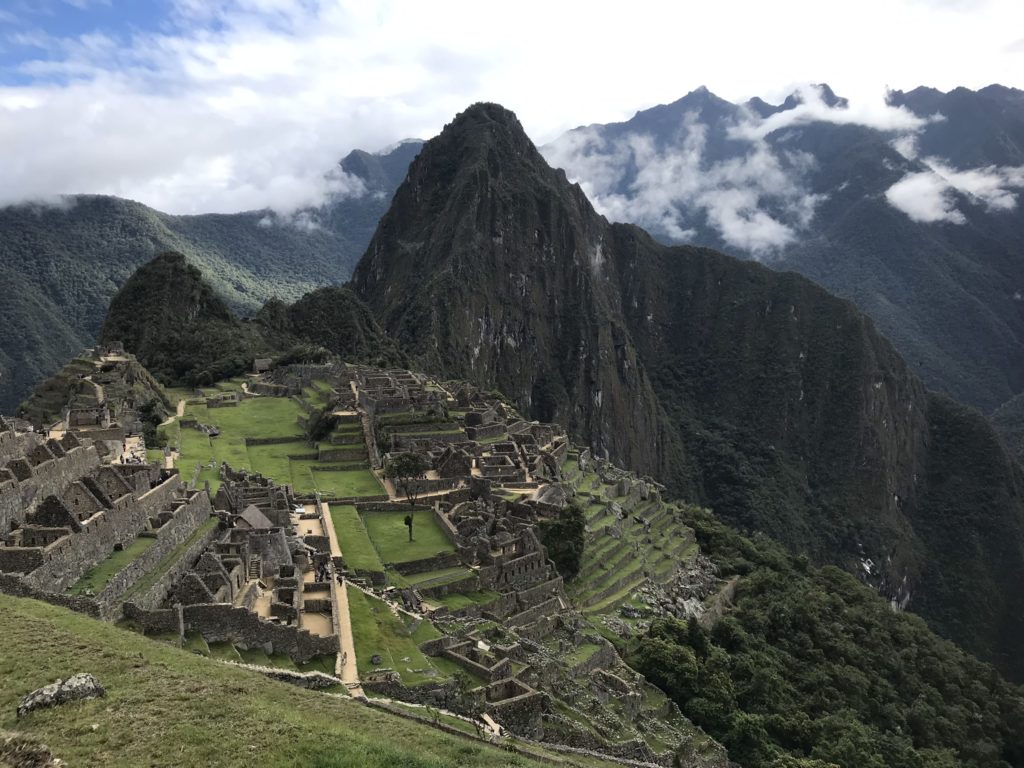
We took a 30 minute bus up Machu Picchu “Old Mountain” and arrived at the city at 8 a.m. (If you prefer, it is possible to hike from the town of Aguas Calientes up to the city.) I was surprised to learn that this city in the clouds sits at an elevation of 8,000 feet (2,430 meters). Although still quite high, it was crazy to think back on the terrain we had covered over the previous four days and how we had ascended to an elevation nearly twice as high as Machu Picchu.
I enjoyed being able to see the city before any tourists entered the ruins. Simply stated, Machu Picchu is worth the journey. I was worried that the site was going to be super touristy and that the scenic views and ancient ruins would not live up to my lofty expectations. Although there were way too many selfies being snapped around me, the picturesque views of the ancient Inca ruins were spectacular and certainly lived up to the hype. After touring around, listening to our guide for a couple of hours, and taking dozens of pictures, we went off to hike Huayna Picchu. Huayna Picchu is the adjoining mountain which is visible in the background of the picture above.
For some reason, maybe it was the hot shower in Aguas Calientes or a good nights sleep in a real bed, I felt fresh, and I climbed up the steep Huayna Picchu steps to the top of the mountain in 30 minutes. I tried not to look down while climbing, as this route is extremely steep and I’m not the best with extreme heights. It was a fun hike, but unfortunately the view of Machu Picchu from the top of Huayna Picchu was obscured by heavy clouds.
After taking a bus back into Aguas Calientes, we grabbed lunch and after a train and van ride our group arrived back in Cusco at 8 p.m. We celebrated our adventure with a team dinner. I called it a night and headed back to the hotel, excited for the adventure that awaited me in Costa Rica the following week.
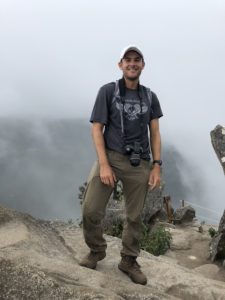
Tanner’s Peru Trekking Tips
- Take acclimatization seriously. It is critical to spend 2+ days in Cusco acclimatizing to the elevation before embarking on a hike to Machu Picchu. I spent two nights in Cusco before the trek and each morning I felt considerably better and found it much easier to breathe than I had the previous night. Also, it is wise to see how your body reacts to the altitude, so you know what to expect once you begin the hike and ascend to even higher elevations. Drink loads of cocoa tea and water (~3 liters of water a day) to help with acclimatization. A few of the members in our group experienced headaches and nausea, but eventually they grew accustomed to the elevation.
- Don’t be cheap with the travel group you select, select a reputable tour guide company. Having a good guide, reliable porters, and fantastic chefs will make your adventure way more enjoyable. I chose Kandoo Adventures, which offers tours all over the world, including up Mt. Kilimanjaro and to Everest base camp. I was very happy with Kandoo. The comapany was able to secure a Huayna Picchu permit for me even though I had signed up for the trek only one week in advance, which is amazing. Our Kandoo guide, chefs, and porters were knowledgeable, kind, and punctual. It was amazing to arrive at the campsite each day and spot your luggage and a washbasin of warm water sitting at the base of your already constructed tent. Also, being woken with a hot mug of cocoa tea made waking up at 5 a.m. way more bearable.
- Get a permit for Huayna Picchu many months in advance. Once you get to Machu Picchu, there is an option to hike up an adjacent mountain called Huayna Picchu. This is a steep one hour hike and, weather permitting, can provide you a nice view of Machu Picchu Mountain and the city from above. If you aren’t afraid of heights and would like to do this hike you must sign up for a permit many months in advance, as these permits are limited and run out rather quickly.
- Bring toilet paper and hand sanitizer on the trek. There are a handful of public toilets along the trail, but these do not have toilet seats, there is no toilet paper, and no sinks.
- Bring bug spray on the trek. As you do not descend into the Amazon during the Salkantay Trek, you do not need the yellow fever vaccination. That being said, without bug spray mosquitoes will eat you alive upon entering the cloud rain forest.
Peru Adventure Takeaways
- Visit Machu Picchu, it is worth the journey.
- Read about the Incas before your visit. I read “The Last Days of the Incas” by Kim MacQuarrie during the week prior to the trek, and I loved being able to recognize historic sites and recall major events that had occurred at particular places. It is super impressive how the Incas built an empire that spanned ~2,500 miles over just three generations. And then Francisco Pizzaro shows up with a couple hundred Spanish men and conquers the Inca population of 10 million!
- Spend a day or two in Lima on your way to Machu Picchu.
- Go on a guided trek in the mountains of Peru, from Cusco to Machu Picchu. If you love hiking, adventure is in your blood, and you are fit enough to make the journey, I recommend hiking from Cusco to Machu Picchu along one of the many routes. Hiking in the mountains of Peru is magical. Peru has 28 different climates out of the world’s 32 and boasts an incredible array of biodiversity.
- Appreciate how lucky you are. Peru’s economy is okay, but it’s infrastructure is poor especially outside of the nicer districts in Lima. Pueblos jóvenes or “shanty towns”, comprised of shacks stacked upon each other, can be seen surrounding Lima and other cities in Peru. You cannot drink tap water anywhere. Nearly all of the restrooms along the trail had no toilet seat, toilet paper, or sinks. (Don’t worry, I was hiking in the mountains so this didn’t come as a surprise). Being able to drink out of the faucet, take a hot shower whenever you want to, and go to the bathroom without bringing your own toilet paper and hand sanitizer, what a treat!
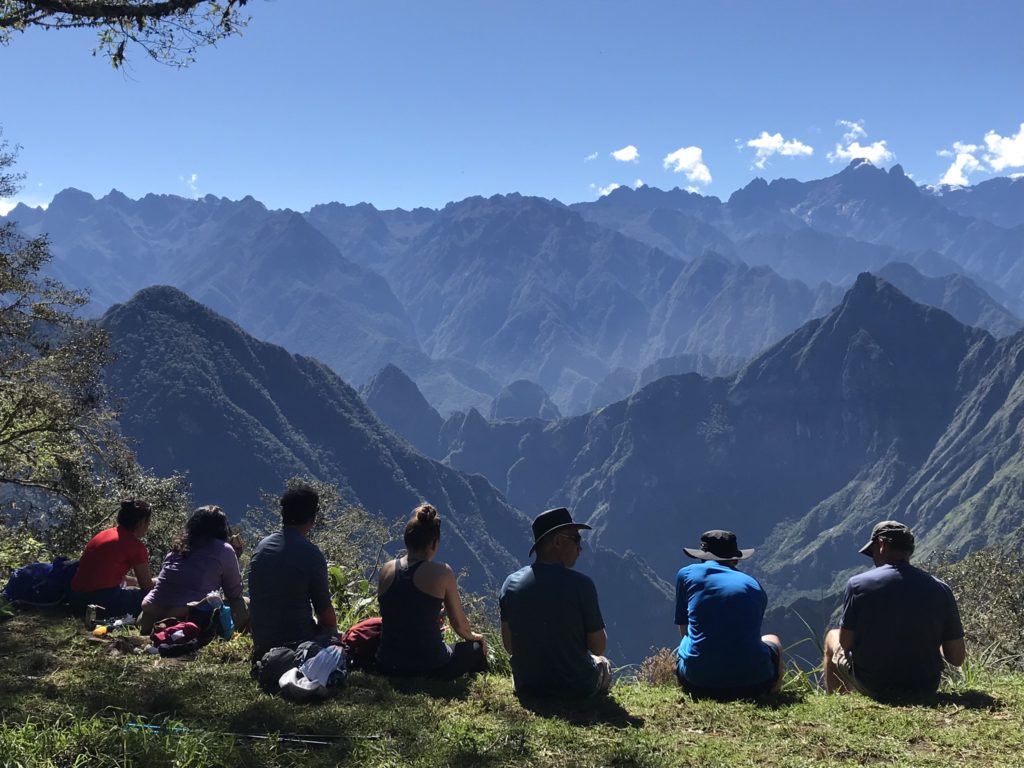
Shout out to my awesome trekking group pictured above, from left to right: Shilpa (“The Healer”), Mita, Rob (“Bert”), Kailee (“El Baño”), Steve (“Stevie Wonder”), Simon (“Ped”), and Don (“Don the Explorer”). Thank you for giving me all of the leftover food and donating the majority of your snack bars. You all saved my life.

